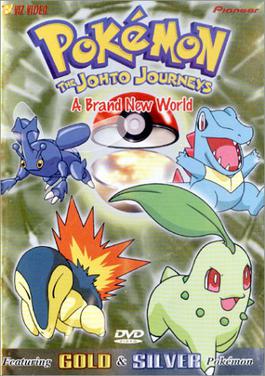Pokémon: The Johto Journeys facts for kids
Quick facts for kids Pokémon: The Johto Journeys |
|
|---|---|

English front cover of the Pokémon: The Johto Journeys DVD collection box, containing the first three episodes of this season
|
|
| Country of origin | Japan |
| No. of episodes | 41 |
| Release | |
| Original network | TV Tokyo |
| Original release | October 14, 1999 – July 27, 2000 |
Pokémon: The Johto Journeys is the third exciting season of the popular TV show Pokémon. In Japan, it's known as Pocket Monsters: Gold and Silver. This season first aired in Japan from October 1999 to July 2000 on TV Tokyo. In the United States, it was shown from October 2000 to August 2001 on The WB (Kids' WB).
This season follows the amazing adventures of Ash Ketchum, a ten-year-old Pokémon trainer. His loyal partner is Pikachu, an electric mouse Pokémon. Together, they travel through the fictional Johto region. Their main goal is to collect Gym Badges. Once they have enough badges, Ash can compete in the big Johto League competition!
The episodes were directed by Masamitsu Hidaka. The animation studio OLM produced the series. In 2000, this show was the top program for boys aged 2–11 in the United States.
Contents
Discovering the Johto Region
This season kicks off Ash's journey in the new Johto region. He meets many new Pokémon and challenges. His main goal is to collect eight Gym Badges. These badges are needed to enter the Johto League.
Ash's New Pokémon Friends
As Ash travels, he catches several new Pokémon. These include a strong Totodile and a loyal Chikorita. He also adds a speedy Cyndaquil to his team. Each new Pokémon brings exciting battles and challenges.
Memorable Moments and Battles
Ash faces many tough Gym Leaders in Johto. He learns new strategies to win. One big moment is when Ash leaves his powerful Charizard in the Charicific Valley. This allows Charizard to train and become even stronger. Ash also helps many other trainers and Pokémon along the way.
Exciting Episodes and Adventures
This season features 41 episodes filled with action and friendship. Here are a few examples of the adventures Ash and his friends have:
|}
Home Media Releases
In the United States, this season was released on VHS and DVD. Viz Media and Pioneer Entertainment released it in 13 separate volumes. The last two episodes, "The Psychic Sidekicks!" and "The Fortune Hunters," were not included in these first sets.
Later, in November 2015, Viz Media and Warner Home Video released Pokémon: The Johto Journeys – The Complete Collection on DVD. This collection included all the episodes from the season.
| 119 | 117 | "Don't Touch That 'dile" (Wakaba Town! Where the Winds of a New Beginning Blow!) Transliteration: "Wakaba Taun! Hajimari o Tsugeru Kaze ga Fuku Machi!" (Japanese: ワカバタウン! はじまりをつげるかぜのふくまち!) |
October 14, 1999 | October 14, 2000 |
|---|---|---|---|---|
| 120 | 118 | "The Double Trouble Header" (The Rookie's Chicorita!) Transliteration: "Rūkī no Chikorīta!" (Japanese: ルーキーのチコリータ!) |
October 21, 1999 | October 21, 2000 |
| 128 | 126 | "The Chikorita Rescue" (The Stubborn Chicorita!!) Transliteration: "Ijippari no Chikorīta!!" (Japanese: いじっぱりのチコリータ!!) |
December 16, 1999 | November 25, 2000 |
| 133 | 131 | "Fighting Flyer with Fire" (Kikyou Gym! Sky Battle!!) Transliteration: "Kikyō Jimu! Ōzora no Tatakai!!" (Japanese: キキョウジム! おおぞらのたたかい!!) |
January 20, 2000 | December 16, 2000 |
| 136 | 134 | "Charizard's Burning Ambitions" (Lizardon's Valley! Until We Meet Again!!) Transliteration: "Rizādon no Tani! Mata Au Hi made!!" (Japanese: リザードンのたに! またあうひまで!!) |
February 10, 2000 | February 3, 2001 |
| 143 | 141 | "Good 'Quil Hunting" (Hinoarashi! I Got It!!) Transliteration: "Hinoarashi! Getto da ze!!" (Japanese: ヒノアラシ! ゲットだぜ!!) |
March 30, 2000 | March 3, 2001 |
| 153 | 151 | "The Totodile Duel" (Whose Waninoko is It!? Satoshi vs. Kasumi!) Transliteration: "Waninoko wa Dare no Mono!? Satoshi Tai Kasumi!" (Japanese: ワニノコはだれのもの!? サトシVSカスミ!) |
June 8, 2000 | May 5, 2001 |
| 156 | 154 | "Fowl Play!" (Different-Colored Yorunozuku! I Got It!!) Transliteration: "Irochigai no Yorunozuku! Getto da ze!!" (Japanese: いろちがいのヨルノズク! ゲットだぜ!!) |
June 29, 2000 | April 28, 2001 |

